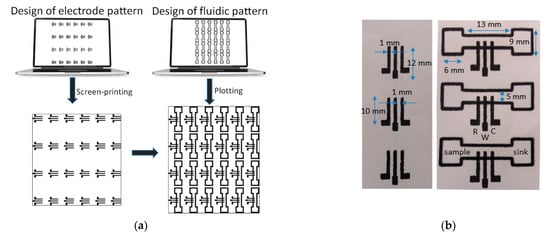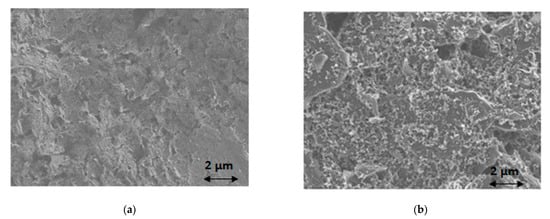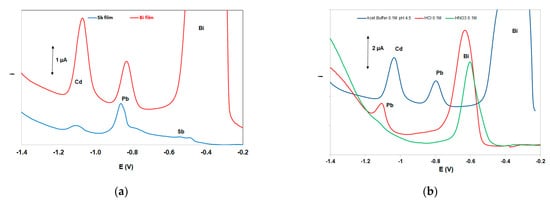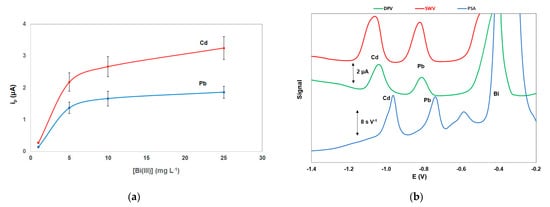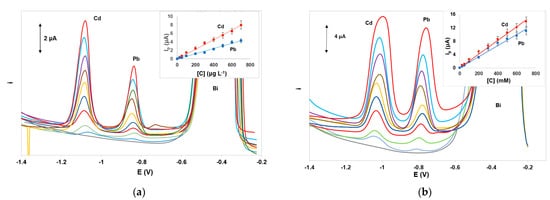Deposition of the three-electrode planar electrochemical cells. These were printed on paper sheets (Macherey-Nagel chromatography paper MN 261, thickness 180 μm) in 24 (4 × 6) arrays and consisted of graphite ink. Layers based the 423SS ink was cured after printing at 90 °C for 5 min using an infrared curing system (LittleRed-X2, VASTEX, Bethlehem, PA, USA). Layers based on the EDAG 407A ink were cured at 90 °C for 60 min in a conventional oven.
Patterning of the PADs. The paper sheet with the arrays of the three-electrode cells was positioned onto a flat glass surface and aligned with the aid of pre-set alignment marks drawn from the sheets and the glass surface. The marker pen was inserted into the holder of the plotter and the 24 (4 × 6) PADs were drawn on the paper using a plotting speed of 0.76 cm s−1 and left at room temperature for 5 min to allow the solvent to evaporate. The pattern was repeated on the reverse side of the paper after aligning the paper. Finally, the paper was cut using scissors to obtain the individual ePADs which were carefully handled using tweezers. The nominal dimensions of the fluidic ePADs designed and fabricated in this work are shown in Figure 1b.
Electrochemical characterization of the ePADs was performed by cyclic voltammetry. CVs were recorded at different scan rates and the anodic and cathodic peaks currents were plotted as a function of the square root of the scan rate. The respective plots were highly linear suggesting diffusion-limited currents.
For the microscopic study, coating of the working electrode’s surface with a bismuth film was performed by adding 100 μL of a 100 mg L−1 Bi(III) solution in 0.5 mol L−1 acetate buffer (pH 4.5) in the sample area of the ePAD and performing deposition at −2.0 V for 420 s after the solution reached the sink zone. Examination of the bare screen-printed working electrode’s surface with SEM reveals the rough surface of the conductive ink (Figure 2a). After coating with bismuth, the electrode surface is covered with bismuth nanoparticles (Figure 2b), suggesting successful deposition of bismuth on the surface of the screen-printed working electrode.
Figure 2. SEM images of (a) bare screen-printed working electrode surface; (b) bismuth-coated screen-printed working electrode surface.
Among the 8 different papers used in our previous work involving pen plotting
[26], the Macherey-Nagel chromatography paper MN 261, Whatman No. 1 chromatography paper, and Whatman No. 42 filter paper were shown to provide the best combination of transport characteristics and line consistency. In this work, the three types of paper provided statistically similar results, and the Macherey-Nagel chromatography paper MN 261 was used throughout.
Among the 17 marker pens tested for the formation of the fluidic channels, the following 5 pens provided satisfactory hydrophobicity for the isolation of the channels: the Staedtler permanent Lumocolor waterproof 0.4 mm (black), the Edding 300 permanent marker water-resistant 1.5–3 mm, the Grand Paint Marker Olejowy paint marker GR-25 1.8 mm, the Edding 780 0.8 mm (black) and the BIC Marking Pro ultra-resistant permanent marker 1.1 mm. The BIC Marking Pro ultra-resistant permanent marker 1.1 mm provides channel isolation with single-sided plotting while the other pens necessitate double-sided plotting. Unfortunately, spurious stripping peaks are obtained with the BIC Marking Pro ultra-resistant permanent marker 1.1 mm, probably to electroactive compounds leaching out of the particular ink. Among the remaining papers, the Edding 780 0.8 mm (black) with double-sided plotting was selected because it provided the best isolation of the channels in the acetate buffer used in this work; a plotting speed of 0.76 cm s−1 was selected.
Two types of graphite ink (Loctite EDAG PF 407A and Loctite EDAG 423SS) were tested for screen-printing under identical conditions. The latter produced the higher stripping peak for Pb and Cd and the best baseline.
The two most widely used “green” metals (antimony and bismuth) were tested for the in situ formation of the metallic film on the working electrode ; both metals were added in the solution at 10 mg L−1. As illustrated in Figure 3a, the bismuth-film working electrode yielded the highest stripping signals for both Cd and Pb, and, therefore, bismuth was selected for the formation of the metal film. Under mildly acidic conditions (as used in this work) in situ-plated antimony, electrodes are known to produce weak stripping signals (probably due to gradual hydrolysis of Sb(III)) and, thus, antimony electrodes are normally used in conjunction with strongly acidic media.
Figure 3. (a) Comparative DP voltammograms at a bismuth-film electrode and an antimony-film electrode, (b) comparative DP voltammograms in three supporting electrolytes. Conditions: 200 μg L−1 Pb(II) and Cd(II); supporting electrolyte 0.5 mol L−1 acetate buffer (pH 4.5) containing 10 mg L−1 Bi(III); deposition time, 420 s; deposition potential −2.5 V.
Three supporting electrolytes (0.5 mol L−1 of HCl, HNO3, and acetate buffer (pH 4.5)) were studied (Figure 3b). Only the sample in acetate buffer produced well-defined peaks for both Pb and Cd and this medium was elected as the supporting electrolyte. The strongly acidic HCl and HNO3 solutions produced higher background currents in the range of the Pb and Cd striping peaks (due to more pronounced proton reduction) which obscured the signals of the target metals.
The effect of the Bi(III) solution concentration used for the in-situ formation of the bismuth film on the stripping peak currents of Pb and Cd is illustrated in Figure 4a; the stripping signals for the two target metals increased with increasing Bi(III) concentration and remained almost constant for Bi(III) concentration higher than 10 mg L−1 which was selected for further work.
Figure 4. (a) Effect of the Bi(III) concentration on the stripping peak heights of Cd and Pb; (b) comparison between differential pulse voltammetry (DPV), square wave voltammetry (SWV), and constant current potentiometric stripping analysis (PSA). Conditions as in Figure 3.
The deposition potential was studied in the range 0.0 to −3.0 V. The stripping signals of both the target metals increased as the deposition potential became more negative and leveled off at −2.5 V which was selected as the deposition potential. The effect of the deposition time was investigated in the range 60–420 s and a linear dependence of the stripping signals of both the target metals vs.
Different stripping modes were investigated for the stripping step (Figure 4b). The constant-current potentiometric stripping analysis (PSA) mode produced a sloping baseline while the sensitivity and speed of the differential pulse (DP) waveform were lower than that of the square wave (SW) mode. However, the SW modulation caused widening of the peaks (in particular the Cd peak) which was more evident at higher metal concentrations.
In this work, a graphite carbon electrode was used as a quasi-reference electrode. Therefore, the peak potentials were highly dependent on the supporting electrolyte used (Figure 3b). However, in the selected 0.50 mol L−1 acetate buffer (pH 4.5) solution prepared from sodium acetate and hydrochloric acid (in order to achieve a constant Cl− concentration which stabilized the potential of the pseudo-reference), peak potentials shifted by no more than ±10% between different ePADs.
Calibration for Cd(II) and Pb(II) was performed in the concentration range 0–700 μg L−1. The calibration features (calibration equation, coefficient of determination, and limits of quantification) for the target metals using DPASV and SWASV are summarized in Table 1. Under the selected conditions, the dynamic range for Pb(II) was 10.0–1000 μg L−1 nd for Cd(II) was 5.0–800 μg L−1. The limit of detection quantification (LOD) for each metal was calculated from the equation: LOD = 3.3 × sb/S (where sb is the standard deviation of the intercept of the calibration plot and S is the slope of the calibration plot and the limit of quantification (LOQ) was calculated as: LOQ = 3 × LOD. Representative voltammograms and calibration plots using DPASV and SWASV are illustrated in Figure 5a,b, respectively. The analytical characteristics obtained with the integrated ePADS were comparable with those achieved with other non-integrated ePADs. Although these values are not as low as other more sophisticated bismuth-based sensors, they are considered adequate for single-use low-cost sensors intended for rapid on-site monitoring of heavy metals in environmental samples since they are lower than the legislative limits in the EU and the USA for drinking water (5.0 μg L−1 for Cd(II) and 10 or 15 μg L−1 for Pb(II)).
Figure 5. Voltammograms and respective calibration plots for the determination of Pb(II) and Cd(II) in the concentration range 0–700 μg L−1 by (a) DPASV and (b) SWASV. Conditions as in Figure 3.
Table 1. Calibration features of the target metals at the ePADs.
| Title 1 |
Cd(II) |
Pb(II) |
| |
DP |
SW |
DP |
SW |
| Slope ± SD (μA μg−1 L) |
1.13 × 10−2 ± 2.3 × 10−4 |
1.96 × 10−2 ± 4.3 × 10−4 |
6.1 × 10−3 ± 2.3 × 10−4 |
1.63 × 10−2 ± 6.4 × 10−4 |
| Intercept ± SD (μA) |
2.0 × 10−2 ± 8.1 × 10−3 |
4.2 × 10−2 ± 1.6 × 10−2 |
5.5 × 10−3 ± 8.3 × 10−3 |
3.5 × 10−2 ± 2.1 × 10−2 |
| R2 |
0.996 |
0.996 |
0.994 |
0.997 |
| LOD (μg L−1) 1 |
2.4 |
2.7 |
4.5 |
4.2 |
| LOQ (μg L−1) 2 |
7.1 |
8.1 |
13.5 |
12.8 |

